 Electrical Box Screw / Tab Repair
Electrical Box Screw / Tab Repair
How to fix a stripped electrical outlet or switch box mounting screw, stripped electrical box screw receiver or broken-off screw tab
- POST a QUESTION or COMMENT about ways to replace an electrical outlet or switch mounting screw when threads are stripped on the screw or in the mounting box.
Repair an electrical box:
This article describes how to repair the mounting screw or screw opening at an electrical box used to mount a receptacle, switch, or other device.
A stripped screw or screw opening at an electrical box is more than annoying, it's unsafe as the device will not be mounted safely and securely to the wall, ceiling or other location.
But if the problem is an over-stripped screw hole on the electrical box, we sure don't want to have to tear out the whole box: well we don't.
Here we describe what to do if the mounting screw itself is stripped and we explain how to tap the electrical box opening if the problem is that that component has become stripped or enlarged.
Our page top photo shows two common screw locations in a metal junction box; Below we illustrate the screw and screw mounting opening or "ear" at a receptacle box.
InspectAPedia tolerates no conflicts of interest. We have no relationship with advertisers, products, or services discussed at this website.
- Daniel Friedman, Publisher/Editor/Author - See WHO ARE WE?
How to fix a stripped electrical outlet or switch box mounting screw or screw opening

Watch out: an electrical box at which the device mounting screw openings are stripped are unsafe. A stripped screw or stripped screw opening will not hold the device (in our photo an electrical receptacle or "outlet" or "wall plug" in common speech) securely in place.
When the device is not held securely and someone is attempting to "un-plug" whatever electrical appliance was connected there, it is possible to pull the whole receptacle, face plate, and wires right out of the building wall.
The risk is a broken electrical connection, a short circuit, or even a dangerous electrical shock or fire.
This is particularly true when the "device" is a comparatively new receptacle that makes a tight grip on a wall plug that has been inserted into it.
If the problem is stripped threads on the device mounting screw itself (see photo) then you can simply replace the screw.
But if the problem is that the device mounting screw opening on the metal or plastic electrical box has been stripped, other steps must be taken.
We will explain those repair steps here.
Article Series Contents
- ELECTRICAL BOX SCREW REPAIR
- METAL ELECTRICAL BOX SCREW REPAIR, METAL BOX MENDER
- PLASTIC ELECTRICAL BOX REPAIR
Replace the Damaged Electrical Box?
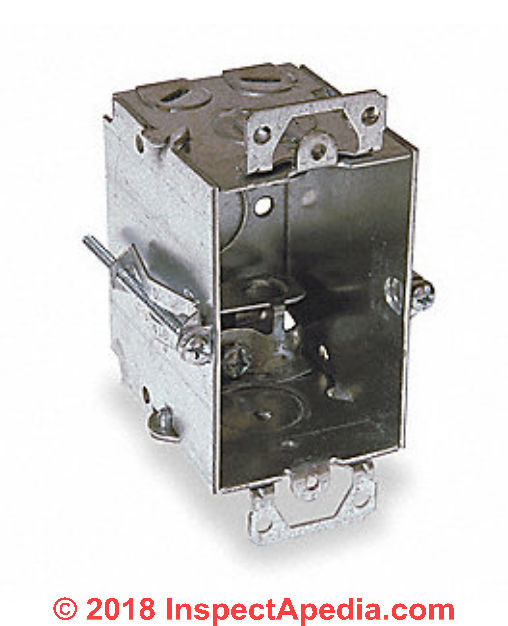 One damaged electrical box option is to replace the entire electrical box, a step that's appropriate if the existing box is damaged beyond safe use, such as by having been cracked, broken, or if metal, if it's quite rusted.
One damaged electrical box option is to replace the entire electrical box, a step that's appropriate if the existing box is damaged beyond safe use, such as by having been cracked, broken, or if metal, if it's quite rusted.
Replacing an electrical box entirely can be difficult as you'll need to turn off electrical power, remove the device(s) from the box, loosen any strain reliefs or clips holding the wires to the box, remove the box from the wires without damaging the wire insulation, and then install a new-old-work electrical box designed for retrofit application.
If the available wire lengths are short this can be a very difficult procedure.
Photo: a "new old work" metal electrical box designed to fit into a wall opening without having to cut the whole wall apart to secure the box to a stud.
However if the body of the electrical box is not actually broken, and if the problem is simply a stripped device mounting screw opening, you can avoid that effort.
Approaches are provided for repairing a stripped or damaged screw receiver in a plastic electrical box are described here.
How to Replace or Repair a Stripped Electrical Device Screw
I the problem is just the device-mounting screw itself is stripped, simply purchase a replacement screw or a handful of them from your electrical supplier. These screws are a standard thread and length, but longer versions are available at any hardware store.
Watch out: if any electrical box repair method cannot provide a very secure mount or screw receiver for the screws that hold an electrical receptacle ("wall outlet" or "wall plug" or "wall socket") in place there is a risk that the whole receptacle may be pulled out of the wall when someone is simply trying to un-plug a power cord that has been plugged in to the receptacle. The result would be unsafe, risking electrical shock, short circuit, or fire.
For this reason, when you are evaluating any approach to repairing an electrical box or stripped screw or stripped screw receiver you must be sure that the repair is of adequate strength to resist pulling on an electrical receptacle secured to that box. Light switches and electrical box covers are not subjected to the same outwards force as is an electrical receptacle.
Typical Electrical Box Screw Size Table |
|
| Electrical outlet or "receptacle" or "wall plug" box | 6 x 32 in lengths from 1/4" and up |
| Electrical wall switch box | 6 x 32 in lengths from 1/4" and up |
| Electrical fixture boxes (to which a ceiling or wall fixture is attached) | 8 x 32 or 10 x 32 in lengths from 1/4" and up |
Notes to the table above
About wall outlet & electrical box cover or device screws
These are standard U.S. screw sizes. The first number is the diameter of the screw (not the head of the screw) and the second number is the thread count - in threads per inch. 6 x 32 = a No. 6 diameter screw with 32 threads per inch.
Screws used to mount a wall receptacle or switch have a flat, slotted head
Screws used to mount a cover to a junction box or to secure a fixture to a box are larger (extra strength needed) and typically have a round slotted head.
In new products often the screws have a head design that can accept a flat screwdriver blade, a phillips type driver, and in some cases a square or even a Torx bit.
Extra-length screws are available and are typically needed when you are installing a box extender, for example to accommodate installing a switch or electrical receptacle through tile or through a kitchen counter back splash board.
How to Fix a Stripped Receptacle or Switch Box Screw Opening: Drill & Tap for a Larger Screw
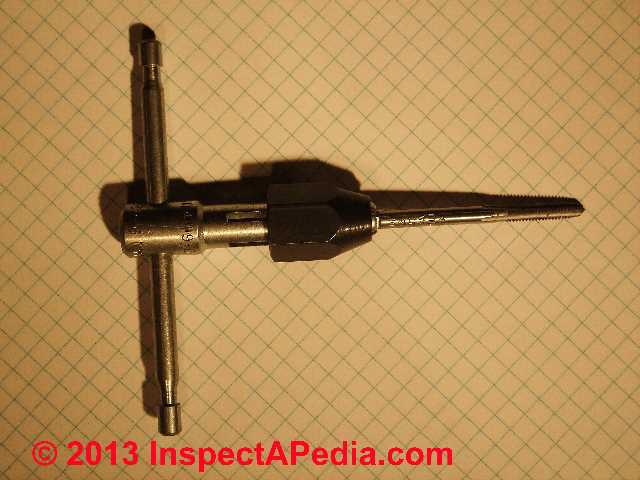
If the stripped problem is that the electrical box mounting hole for a receptacle, light fixture or other device has become stripped, you'll need to enlarge and tap the hole for the next size larger screw and tap threads for the new screw.
It's really easier and cheaper than you might think to fix a stripped mounting hole in an electrical box.
Our photo (above left) shows an 8/32 tapping tool ready to cut threads into that stripped electrical receptacle or switch box mounting screw hole.ger screw size, or replace the box if you can.
You may be able to get away with just drilling out the screw-receiving tab in the electrical box and using a self-tapping screw for the repair.
Drill & tap electrical box repair
Photo below: a closer look at a thread-cutting or "tapping" bit that is turned by hand in a drilled-opening to cut the proper threads for a larger screw to replaced an existing stripped screw opening.
Steps in Drill and Tap Electrical Box Screw Repair
1. Drill the larger screw opening. Taking care to move electrical wires out of the way of your drill bit, in a metal electrical box you can drill out the 6/32 screw opening
2. Use a thread tapping bit and T-wrench (shown above) to hand-turn the bit in the drilled opening to cut threads that will accept an 8/32 screw.
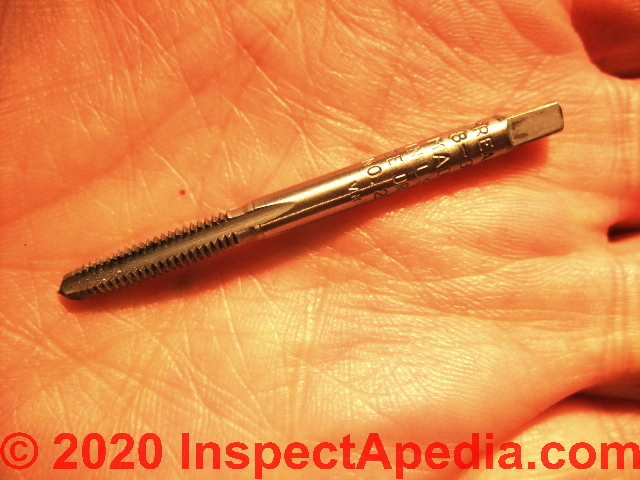 In sum you simply drill out the existing but stripped screw receiver in the (metal or plastic) electrical box to receive a larger screw, taking care to avoid sharp tipped screws and pierced electrical wiring.
In sum you simply drill out the existing but stripped screw receiver in the (metal or plastic) electrical box to receive a larger screw, taking care to avoid sharp tipped screws and pierced electrical wiring.
This sounds like a bit of work, and there's the extra cost to purchase the right sized tapping drill bit (Tap drill No. 29, Body drill, No. 19 for an 8/32 or 8/36 screw) along with the actual tapping tool.
On the other hand, if you can't borrow these little parts from someone, I'd argue that the cost of buying them is less than the trouble of tearing out and replacing the whole electrical box in a finished wall.
If the screw receiver "ear" in a plastic or steel electrical box has broken off completely this approach won't work and you'll need to use electrical box repair method #2 below.
How to Use a Repair Clip to Repair Damaged Screw Opening in Plastic Electrical Boxes
Plastic electrical boxes of a great range of sizes and applications are produced in several colors, most-often blue or gray, by a range of manufacturers including Carlon, or Lamson-Carlon, Thomas & Betts, and Uxcell (blue plastic) and by Cantex or Taymac, or Sigma Electric, Ogmar, Nineleaf, Greenfield, LeMotech, Altelix, BestTong, AWclub, or even Carlon who produce gray plastic boxes.
It is possible to strip the screw opening in these electrical boxes, in our opinion, probably due to use of a power-drill operated or other powered screw-driver that over-drives the electrical component mounting screw during installation.
Over-Torquing or over-tightening the screws using a powerful drill-operated screwdriver set to too-high torque is discussed separately
at OLD WORK BOX TORQUE FAILURE
Insert Metal Repair Clips for electrical box repair
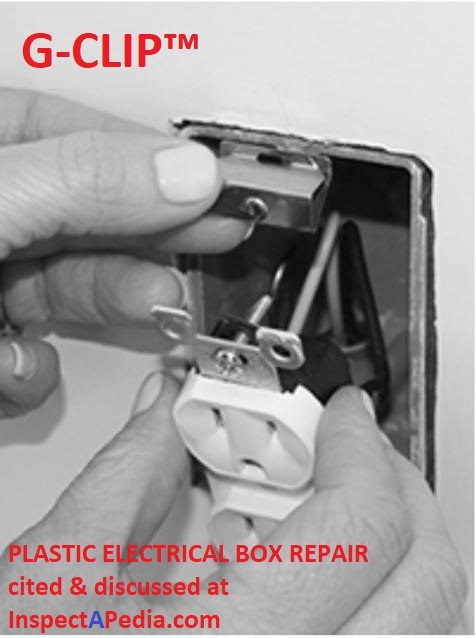 Use a patented plastic electrical box screw connector metal repair clip such as the G-Clip shown above.
Use a patented plastic electrical box screw connector metal repair clip such as the G-Clip shown above.
Photo: repairing a stripped plastic electrical box screw opening using Michael Walton's patented G-Clip™ discussed below.
From a review of the manufacturer's website it looks as if this metal spring clip is designed for the thickness of plastic electrical boxes in which the original plastic screw receiver or "ear" remains in place but has been stripped or damaged.
Other photos at Mr. Walton's G-clip website suggest that this clip may also work to repair some stripped-screw-opening at metal electrical boxes too, provided it pinches sufficiently tightly onto the edge of the box as to remain in place.
This device is a steel spring-clip that slips over and onto the edge of the plastic electrical box to provide a connector that accepts OEM standard electrical device screws such as those used in electrical switches or receptacles.
- Watch out: risk of death by electrocution: Turn off electrical power and confirm that it is off at the electrical box to be worked-on
- Remove the electrical receptacle, switch, or junction box cover
- Remover the electrical device such as electrical receptacle or switch
- Center the G-clip repair device in position over the proper screw mounting hole location and push it into place.
When installing the G-clip screw retainer you'll see that there is an "up" and "down" side: the upper side of the clip includes a slot that will accept a flat-bladed screw driver to pry the clip open should you need to remove or re-position it, and the thinner portion of the screw opening in the clip will be pointing to your left if you are installing the clip in the top of an electrical box. - Push the device (receptacle or switch) back in position for fastening to the electrical box, taking care not to crimp, nick, damage or loosen any of the wires.
- The clip is pressed into place as you start threading the replacement screw
- Complete installing the screw that holds the receptacle or switch in place, replace any remaining screws and replace the device cover.
- Restore electrical power and check that your circuit is functioning properly and safely.
- Watch out: the G-clip manufacturer shared with us these additional warnings and installation advice for using that product:
The G-Clip should never be used to ceiling mount a light fixture on a plastic box on a horizontal plane. The weight of the fixture could overcome the holding grip of the G-Clip on the plastic box itself, resulting in an installation failure.
...
In reference to plastic ceiling fixture boxes. Never use a plastic ceiling fixture box to install a ceiling fan unless the mounting box is rated for use as a fan mounting box.
...
In reference to the G-Clip repairing metal boxes. The G-Clip was designed and engineered to repair and or replace damaged, stripped or missing mounting points used in PVC (plastic) electrical boxes.
While some customers have reported that they have been able to repair a metal box using a G-Clip, it was not intended for that use.
- Contact: G-Clip Plastic Electrical Box, G-CLIP REPAIR of stripped, broken plastic electrical boxes:
Website: www.g-clip.us.html Email: gclipsales@gmail.com - Contact: Metal Box Mender: for repairing metal electrical boxes in the U.K.
Note: this repair clip might work on electrical boxes in some other countries as well. However we found that variations in electrical box design and dimensions may give some aggravation when trying to use this plastic-insert screw holder.
See METAL ELECTRICAL BOX SCREW REPAIR, METAL BOX MENDER
Watch out: As far as we've been able to determine, none of the electrical box repair methods described in this article has been listed by an accrediting agency in the U.S., Canada, the U.K., Australia, New Zealand, the E.U., India, or other electrical safety, code or compliance testing and certifying bodies.
That's no surprise as most building codes set standards for new work rather than repairs of damaged equipment.
Metal Repair Clips Won't Fit on Some Models of Plastic Electrical Boxes
It is apparent that not all plastic electrical boxes will accept a G-clip type electrical box repair device. Both the rectangular plastic electrical box at below left and the round retrofit-type plastic electrical box shown at below-right are constructed with screw receivers cast into a box rib (red arrows).
The blue plastic box at below left is a new-work electrical box with nails intended for driving into a wall stud or ceiling joist, while at below right is an old work electrical box intended for retrofit box installation through a drywall or plaster ceiling or wall.
Also see this ZIP BOX for another example of an old work retrofit electrical box in a rectangular style.
The rectangular box at below left has screw receivers only at the box corners: not a location where a metallic repair clip will fit.

The round plastic old work electrical box at below right, produced by Carlon provides 18 cubic inches of wiring space and enjoys a wide surface-mounting flange (orange arrow).
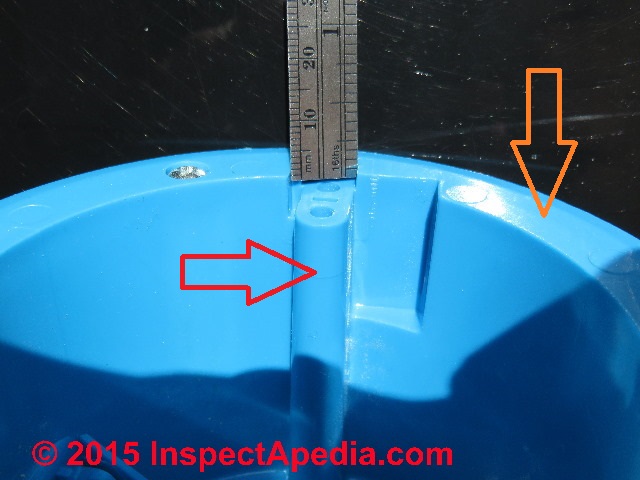
That flange is not a surface over which the G-clip would fit unless the box itself were modified by cutting away portions of its material.The recessed location of the screw receiving opening on this round box leaves us doubtful that a repair clip repair is possible for these electrical boxes.
These round plastic electrical boxes do sport a nice feature if you are worried about piercing an electrical wire while using a make-shift repair screw. The red arrow in the photos show that the device mounting screw receiver on these plastic boxes is manufactured with a deep rib running the full depth of the box.
At no point would a wire inside the electrical box be exposed to damage from the fixture mounting screw, as the screw passes through the hole above the red arrow tip continues inside of the raised rib.
What if I Broke Off Completely the Little Metal Ears Whose Holes Accept the Outlet or Switch Mounting Screw?
Watch out once more: don't try bending that metal ear on the electrical box or junction box - if you break it off then you're most likely going to have to tear out and replace the whole thing.
But before tearing out an electrical box, receptacle, or switch assembly and wiring because this horrible problem has happened to you, look for one of several patented outlet box cover products that include bendable mounting clips that are intended to secure the cover and in some applications the outlet in the box.
Both Michael Walton PLASTIC ELECTRICAL BOX SCREW REPAIR and Pimentel, Demetrio (Atlanta, GA) have patented devices that might work in this case. [2]
Metal Box Mender Repairs for Stripped Screw Holes in Metal Electrical Boxes

In the U.K. inventor David Sexton provides his invention, "Metal Box Mender" a kit that "mends threadbare screw holes in electrical metal boxes without replacing the box and without damaging surrounding area of the box."
This product uses a plastic screw retainer, a pin to hold the retainer in place during assembly, and a manufacturer-provided screw.

Details are at METAL ELECTRICAL BOX SCREW REPAIR, METAL BOX MENDER
U.K. readers who need to repair a stripped screw mounting hole on an electrical box should contact the Metal Box Mender inventor, David Sexton at the addresses given below.
- Metal Box Mender, 3 Wakering Road, Shoeburyness, Southend-on-Sea, Essex SS39SY UK, Tel: 074692 12318 Email: metalboxmender@outlook.com, Website: http://www.metalboxmender.com/
Quoting the company's website: "Repair the stripped thread screw hole in electrical metal boxes. The new "Mender" has been developed to be fitted in seconds without compromising the safety of the box."
My understanding is that the MBM or Metal Box Mender, sold directly from the producer and also sold in Ebay (£2.88 postage paid (VAT included) for Single packs of 2 Menders), has not been tested nor listed for use in the United States nor Canada.
For North American, Australian, New Zealand, Canadian or other applications, look for a product listing and approval that applies in your country.
Use a Speed Clip or Sheet Metal Nut or Clip for Stripped Electrical Box Screw Opening Repairs?
Can I just Use a Sheet Metal Screw or a Little Clip to Hold the Switch or Outlet Mounting Screw?
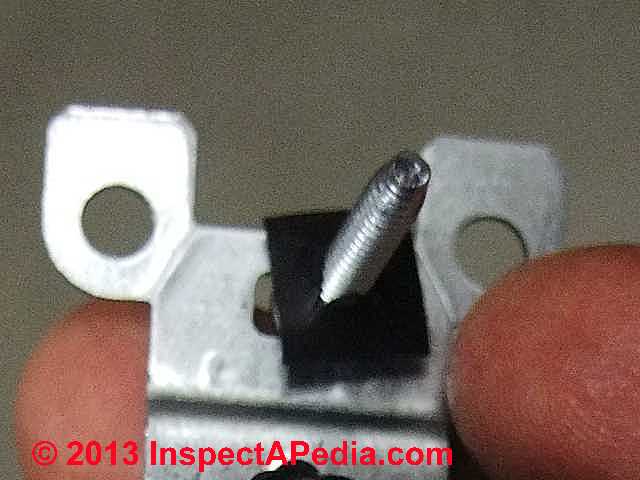
Watch out: Do not try using the little retainer that you find on the ear or back of an electrical receptacle or switch (photo at left) to substitute for a secure mount in the electrical box.
Shown in our photo (left) is a simple retainer intended to prevent loss of the mounting screw prior to installation of the receptacle or switch into the electrical box.
This little clip may be made of metal or just cardboard or plastic.
But in any case it is not designed to be removed and then used over the electrical box mounting tab to hold the receptacle or switch in place. This little clip lacks the strength, is not intended for device mounting, and would be an improper and unsafe installation.
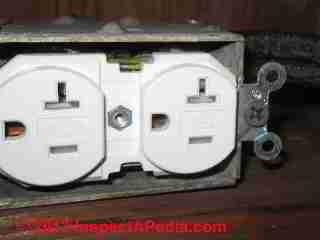
Watch Out: don't use a pointed screw like a drywall screw (photo at left) or a sheet metal screw to secure a receptacle or switch to the box. Depending on wire positions in the wall or the length of the screw you could cause an ugly short circuit now or in the future. If the electrical mounting screws are stripped, replace the screw, tap the mounting hole for the next larger screw.
Patented Support Clip Secures Electrical Devices in a Junction Box
Since Larry Mears patented a support clip intended for supporting electrical fixtures in a junction box in 1987, [1] it may indeed also be possible to purchase a spring-metal clip-on adapter that slips over the stripped ear through which the original hole passed. We're looking for a retail outlet and accepted use of the Mears clip, and similar or related devices have been patented by Union Insulating Company and by TRW, Inc.
A similar solution to stripped plastic electrical box screw connectors, the G-Clip, has been patented by Michael Walton and is discussed below
at PLASTIC ELECTRICAL BOX SCREW REPAIR and illustrations at the company's website suggest that the G-Clip might work on some metal electrical boxes as well.
For metal electrical boxes used in the U.K. David Sexton has invented a plastic insert that can accept a coarse-threaded screw of proper dimension and shape
See METAL ELECTRICAL BOX SCREW REPAIR, METAL BOX MENDER
Similar support clip type devices, used more widely in automobiles and other components are basically a little clip made of spring steel that slips over the existing metal "ear" on the electrical box. The clip is stamped and cut to accept threads of a particular screw size.
Watch out: I don't recommend this repair because I'm not sure this repair would be code-approved and I don't like adding little parts that get lost by the next repair person.
Also without testing and certification we don't know if the strength of the metal clip is sufficient to withstand the withdrawal force of a tightly-gripped wall receptacle plug.
Separately we've already warned about using any screw or clip repair on ceiling electrical boxes from which fans or heavy light fixtures are suspended as the entire assembly could fall.
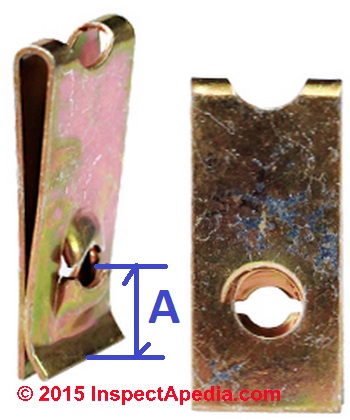 ...
... 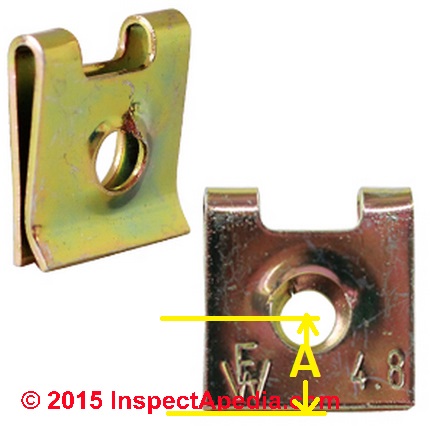
Using a Sheet Metal Screw or Drywall Screw to Repair a Stripped Electrical Box Screw or Screw Receiver
Watch out: OPINION: I do not recommend using a sheet metal screw to "fix" stripped electrical box screws or screw receivers even though it's tempting. Similarly, do not use drywall screws - also tempting.
The sharp point on the sheet metal screw or drywall screw can pierce and short a wire inside the junction box. You or someone else later will be sorry. However since many people have asked about this repair procedure we describe it here.
The following procedure describes what your licensed electrician will probably do:
- Turn off electrical power -
Watch out: danger of death by electrocution: turn off all electrical power and confirm that it is safely off. Do not touch, handle, open or mess with electrical wiring if you are not properly trained, experienced, equipped. A mistake can be fatal. - Remove the switch plate or electrical receptacle cover
or junction box cover - Remove or move out of the way any electrical devices
such as a light switch or receptacle, wiring or spices - Adjust the screw receiver opening diameter:
If necessary drill out the stripped screw receiving tab or "ear" in the electrical box to a diameter sufficient to accept your replacement screw - Select an electrical box repair screw
of the proper length and diameter and be sure that you've clipped and filed its point off to a blunt end to reduce the chances of a fire or electrocution hazard that can occur if your screw pierces an electrical wire.
For older electrical boxes using armored cable you'll need to be sure that the screw is short enough that it won't bang into the BX or armored cable clip mounted in the side of the electrical box. And your screw will need to be long enough to pass through the mounted electrical device or box cover as well as through the spring clip or sheet metal nut. - Install a screw retainer if needed:
for screw receivers that are so stripped as to no longer accept a screw, or where the new screw would be too large in diameter to fit the opening in the mounting ears of the device (switch or receptacle or box cover) being secured,
select a spring clip or speed clip to match the electrical box repair screw diameter and be sure that the speed clip's dimension "A" (shown in blue and yellow above) will allow the clip to be pushed far enough onto the electrical box screw receiver that the hole in the clip will line up over the hole in the screw receiver.
Obligatory warning: for safer results select an electrical box screw repair product designed and sold and listed for electrical box repair.
Watch out: The spring clips shown at above left may be too long in dimension "A" and in addition the remainder of the clip is also unnecessarily long and may interfere with mounting an electrical switch or receptacle.
Use shorter clips such as those shown at above right and labelled with the yellow "A". The clips shown at above right use a "full back" that provides a more secure grip on the screw than some other versions of speed clips that may use a little spring instead.
Watch out: Be sure that your speed clip or sheet metal clip is able to handle the thickness of the metal ear or screw receiver of your electrical box. U.S. electrical box metal walls are generally around 1/16" thick (0.0625")
- this is much thicker than a typical automobile sheet metal panel. Most speed clips operate on panel thicknesses between 0.10" and 0.232" and some of these may break if bent open too much on a thicker mounting location.
However "thick panel speed clips" are available in thicknesses up to 2-3 mm thick, that is, thicknesses up to 0.12".
Note: as long as you're going the Speed Clip / Nut route, some of these products are designed to accept machine-thread screws.
That means that if you select the properly-sized sheet metal speed clip or nut it will accept OEM electrical device screws and you can avoid the issue of non-standard screw sized and dangerous sharp screw points. - Double check wire locations:
When replacing the electrical switch, receptacle or splice be sure that you're not pushing any wires into a spot where they'll be pierced or damaged by the electrical box repair screw. - Restore electrical power,
check electrical circuit operation and safety.
Sources of Steel U-Nuts, Spring Clips, Sheet Metal Nuts, Spring Steel Nuts that some people use for repairing a stripped or broken-off electrical box screw tab
The synonyms for these fastener clips are several: Steel U-nuts, Spring clips, Fairing Nut Clips, Spring Steel Nuts, Sheet Metal Nuts, or just "metal fasteners: which can make finding the proper type of clip to accept and hold a screw in place a bit of a challenge.
- Acco Klix Metal Fasteners
- Automobile parts repair or supply stores such as Auto Zone
- BM Approved Manufacturing, Website: www.belmetric.com Tel: 978-649-6201
- Bolt Products, Inc., Website: www.boltproducts.com TEl: 800-423-6503 - this company's product line includes thick panel speed clips
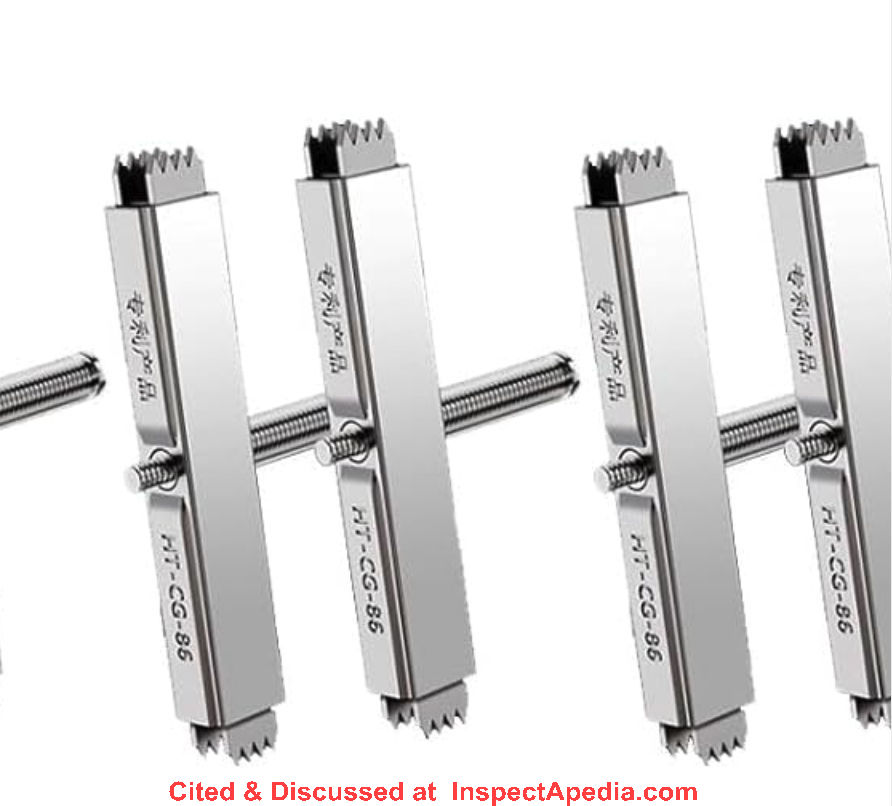 height="320"/>
height="320"/>
- Eagles electrical box / cassette box repair device for missing or broken screw tabs (shown above) for UK and other readers using 86mm wide electrical boxes. Repair devices such as this one only work in a box of the specific width that matches the length of the repair device.
- Fender clips and molding clips from some auto manufacturer suppliers may also work in this application
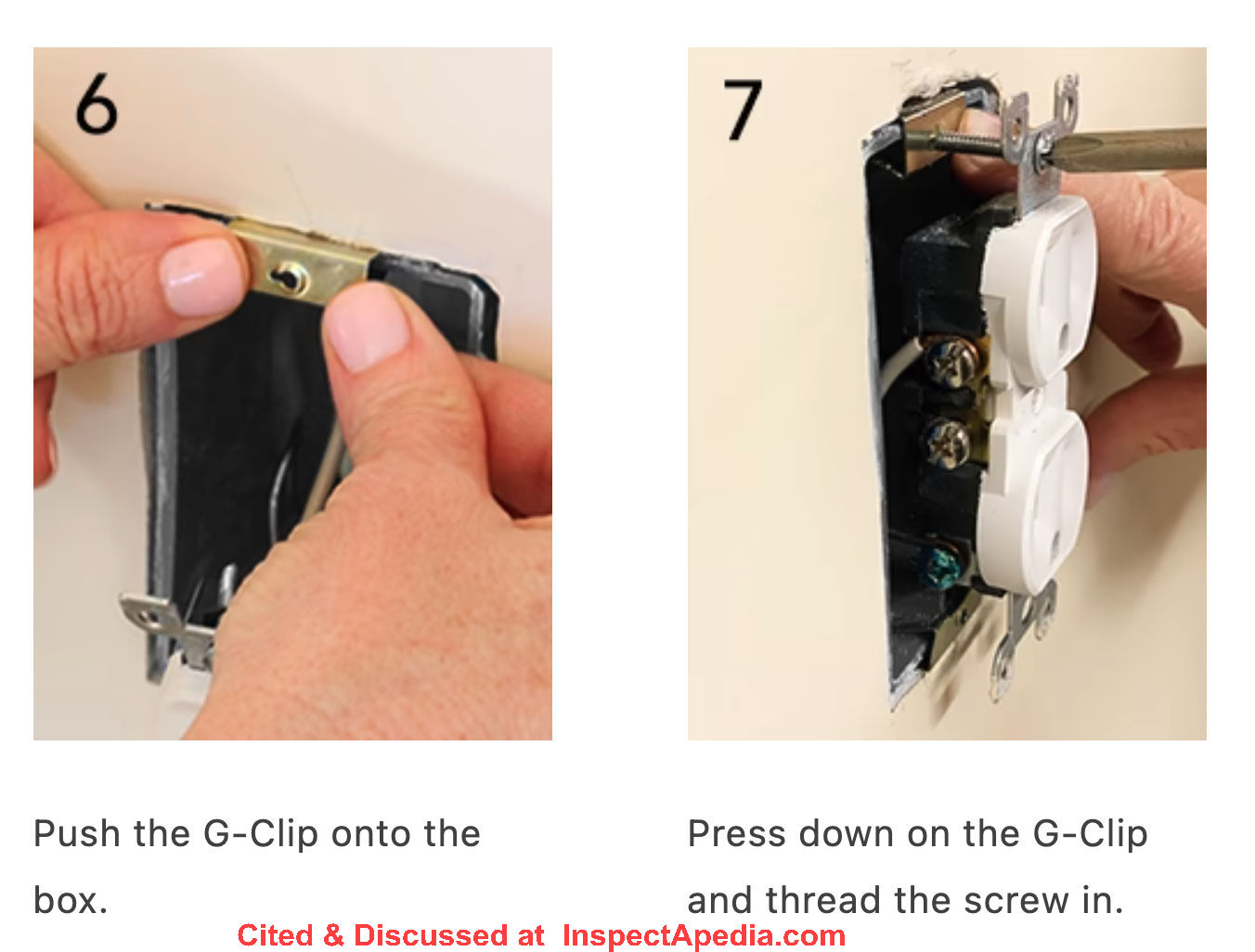 height="320"/>
height="320"/>
- G-Clip, Website: www.g-clip.US.html Email: gclipsales@gmail.com - this U.S. company sells metal clips specifically designed for repairing broken-off or stripped screw receivers in plastic electrical boxes.
- see PLASTIC ELECTRICAL BOX SCREW REPAIR - Hardware Stores & some lumber suppliers who have large hardware departments such as Loews or Home Depot

- Metal Box mender, for U.K. electrical box repairs, (shown above) Metal Box Mender, 3 Wakering Road, Shoeburyness, Southend-on-Sea, Essex SS39SY UK, Tel: 074692 12318 Email: metalboxmender@outlook.com, Website: http://www.metalboxmender.com/
-
see METAL ELECTRICAL BOX SCREW REPAIR, METAL BOX MENDER
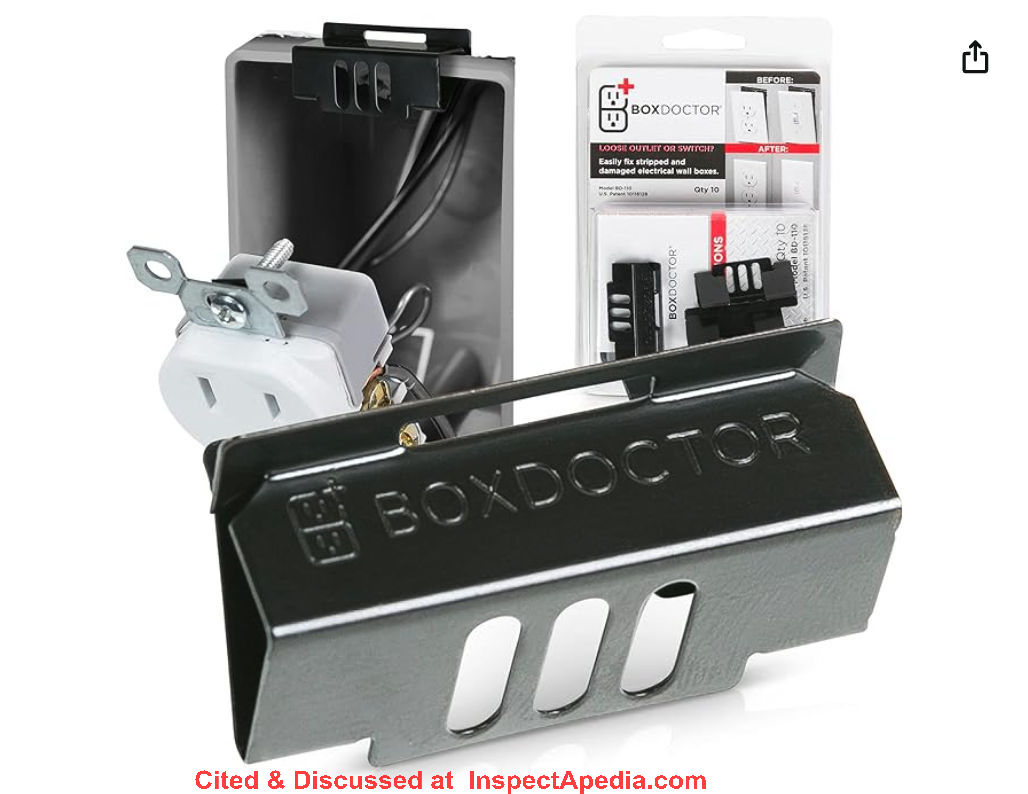 height="320"/>
height="320"/>
- PNL Products. "Box Doctor" shown above - sold on Amazon and at local electrical suppliers. PNL says their clip will work on both plastic and metal boxes suffering from a broken-off screw tab.
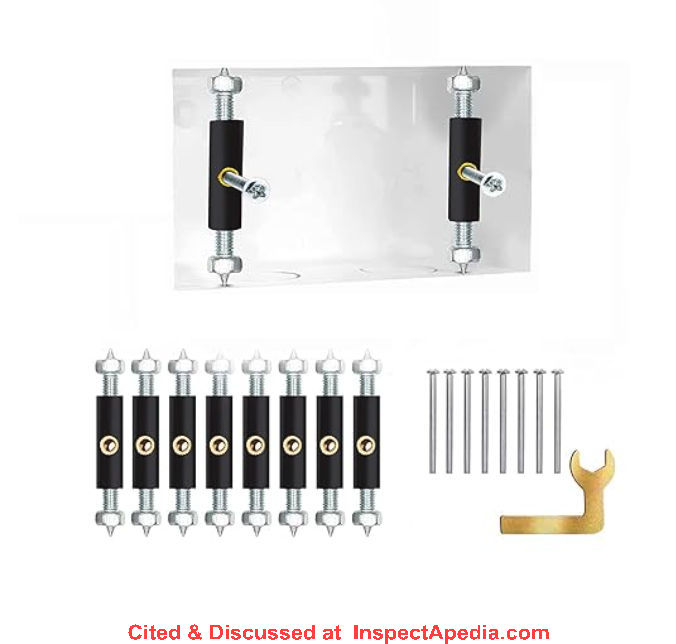 height="320"/>
height="320"/>
- Sanyom electrical box repair product YSDFQ-1, shown above, same sources as above.
Technical note on the illustrations in this article: the metal electrical boxes used in this article were selected to permit illustration of the electrical box screw repair parts and installation procedures.
The boxes themselves may not be of adequate size in cubic inches and certainly do not include the hardware that would be needed to mount these boxes in a building wall.
Watch out: we have found no code approval nor listing agency listings or approvals for any electrical box repair methods, hardware or approaches. Check with your local electrical inspector about the acceptability of your repair approach.
Electrical box replacement rather than screw or screw receiver repairs will be required in some situations such as ceiling boxes carrying weight as well as by local electrical code inspectors.
...
Reader Comments, Questions & Answers About The Article Above
Below you will find questions and answers previously posted on this page at its page bottom reader comment box.
Reader Q&A - also see RECOMMENDED ARTICLES & FAQs
Question: I'm installing a box extension but the top screw won't hold - it's stripped
I started installing a box-extender on a receptacle in my kitchen because I'm tiling my backsplash and need to raise the outlet above the tile.
However, the top screw connecting the outlet and box wouldn't hold. I spent way too much time bent double under my cabinets trying to get it to bite, but when I finally gave up and pulled it out it was stripped at the tip (which was as far as it'd go in).
I'm sorry to bother you with triviality, but I'm new to home renovations and don't know what to do. Advice? - Julia 1/29/13
Reply: tips for replacing a stripped electrical receptacle or switch box mounting screw or screw opening
Julia,
Don't feel bad, this stripped receptacle mounting screw problem has confronted countless electricians and electrical workers.
It's always comforting to realize that for just about any problem we encounter, someone else has met it before, and there is almost always a known solution. In fact this problem has been around at least in the U.S. since we figure about 1918 when the first outlet box support device was patented. [1]
At separate articles
on ELECTRICAL OUTLET, HOW TO ADD & WIRE and
on OLD HOUSE ELECTRICAL SYSTEMS people have asked more than once how to fix a stripped screw or stripped mounting screw at an electrical box for an outlet (properly a receptacle), switch, or to suspend a light fixture or just to hold a box cover in place.
On 2020-01-11 by (mod) - how to reduce a 1-inch knock-out opening down to 3/4-inch.
 Carolyn,
Carolyn,
Electrical suppliers sell a reducing bushing that can adapt the existing 1-inch opening to 3/4-inch.
Two widely-distributors, Thomas and Betts, and Halex, sell a 1-inch to 3/4-inch reducer bushing that will work perfectly for you. An illustration of one of these products is below.
Incidentally as your name is an unusual one, are you related to my much-missed old friend Elaine Luthy?
On 2019-03-14 y Carolyn Luthy
I have a 1 inch hole in my fuse box but want to attach a 3/4 inch connector there - what do I do.
...
Continue reading at METAL ELECTRICAL BOX SCREW REPAIR, METAL BOX MENDER or select a topic from the closely-related articles below, or see the complete ARTICLE INDEX.
Or see ELECTRICAL BOX SCREW REPAIR FAQs - questions and answers posted originally on this page.
Or see these
Recommended Articles
- ELECTRICAL BOX TYPES
- ELECTRICAL BOX GROUND WIRING
- ELECTRICAL JUNCTION BOX TYPES
- ELECTRICAL OUTLET, HOW TO ADD & WIRE
- PLASTIC ELECTRICAL BOX REPAIR - repair a broken plastic electrical box using an "old work" box: wiring, sealing, grounding.
Suggested citation for this web page
ELECTRICAL BOX SCREW REPAIR at InspectApedia.com - online encyclopedia of building & environmental inspection, testing, diagnosis, repair, & problem prevention advice.
Or see this
INDEX to RELATED ARTICLES: ARTICLE INDEX to ELECTRICAL INSPECTION & TESTING
Or use the SEARCH BOX found below to Ask a Question or Search InspectApedia
Ask a Question or Search InspectApedia
Questions & answers or comments about ways to replace an electrical outlet or switch mounting screw when threads are stripped on the screw or in the mounting box.
Try the search box just below, or if you prefer, post a question or comment in the Comments box below and we will respond promptly.
Search the InspectApedia website
Note: appearance of your Comment below may be delayed: if your comment contains an image, photograph, web link, or text that looks to the software as if it might be a web link, your posting will appear after it has been approved by a moderator. Apologies for the delay.
Only one image can be added per comment but you can post as many comments, and therefore images, as you like.
You will not receive a notification when a response to your question has been posted.
Please bookmark this page to make it easy for you to check back for our response.
IF above you see "Comment Form is loading comments..." then COMMENT BOX - countable.ca / bawkbox.com IS NOT WORKING.
In any case you are welcome to send an email directly to us at InspectApedia.com at editor@inspectApedia.com
We'll reply to you directly. Please help us help you by noting, in your email, the URL of the InspectApedia page where you wanted to comment.
Citations & References
In addition to any citations in the article above, a full list is available on request.
- [1] Larry E. Mears, "Support clips for supporting electrical fixtures in a junction box", Patent number: 4679882
Filing date: Sep 17, 1985
Issue date: Jul 14, 1987, Description: Support clips for supporting the mounting brackets of an electrical fixture in a junction box are disclosed.
The clips are formed from a single piece of sheet material and are adapted at one end to be crimped between the junction box and the junction box cover, and at the other end to engage and support the mounting brackets disposed on the ends of the fixture.
In the case where the electrical fixture is a duplex receptacle, the clips serve to prevent the pivoting of the receptacle about a single center mounting screw during insertion of a plug into one of the receptacle outlets, and thereby prevent the mounting screw from loosening after repeated usage of the receptacle. retrieved 3/4/2013 - [2] Pimentel, Demetrio (Atlanta, GA), patent application No. 10/058762, filed 01/30/2002, is described as follows:
A cover for an electrical outlet box which includes a plurality of bendable mounting clips constructed unitarily with the cover. In use, the mounting clips are oriented perpendicular to the outlet box cover and extend outwardly through an opening in a wall structure with the outer ends of the mounting clips then being bent outwardly into overlying engagement with the exterior of the wall surface in opposed relation to the outlet box cover thereby mounting the outlet box, and cover on the wall structure in alignment with the opening in the wall structure.
The outlet box cover is mounted on the outlet box in a conventional manner and the mounting clips on the outlet box cover extend from the periphery of an opening in the cover for mounting electrical sockets, switches or the like in the outlet box in a conventional manner. Retrieved 3/4/2012 - In addition to citations & references found in this article, see the research citations given at the end of the related articles found at our suggested
CONTINUE READING or RECOMMENDED ARTICLES.
- Carson, Dunlop & Associates Ltd., 120 Carlton Street Suite 407, Toronto ON M5A 4K2. Tel: (416) 964-9415 1-800-268-7070 Email: info@carsondunlop.com. Alan Carson is a past president of ASHI, the American Society of Home Inspectors.
Thanks to Alan Carson and Bob Dunlop, for permission for InspectAPedia to use text excerpts from The HOME REFERENCE BOOK - the Encyclopedia of Homes and to use illustrations from The ILLUSTRATED HOME .
Carson Dunlop Associates provides extensive home inspection education and report writing material. In gratitude we provide links to tsome Carson Dunlop Associates products and services.

